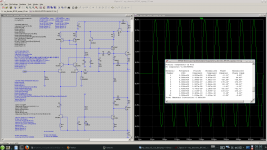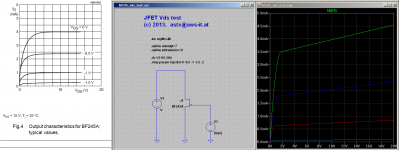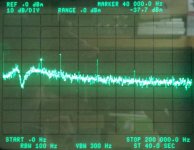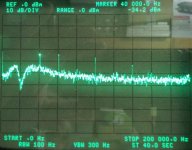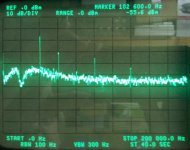OT: discrete opamp
Why is the THD20k now 10 times better on using a BF245 also for CCS?
Is this a simulation error? Or does the "bad" CCS behaviour of the BF245 cancel out errors from the input JFET's?
Why is the THD20k now 10 times better on using a BF245 also for CCS?
Is this a simulation error? Or does the "bad" CCS behaviour of the BF245 cancel out errors from the input JFET's?
Attachments
Last edited:
Thx. Don't know how to do this. The next days I will test in real life if sim is predicting correctly. All other sim results are exactly corresponding to real life measurenents like thd, fft figures at unity gain and 20db gain.Have you checked the Jfet model for accuracy regarding Vds curves?
Maybe you have a hint how to check the jfet model?
Br, Toni
Set up a simulation with the CCS as it is now, and sweep the drain voltage from 0 to Vdsmax. It should be similar to the Vds curves in the datasheet. My experience however is that no Jfet model in LTSpice has ever had realistic Vds curves. Yet, I've never heard anyone complain about it nearly as much as they complain about BJT and MFET models.
However, I've rarely had an LTP CCS contribute significantly to distortion. Even a resistor bootstrap can work here, especially since you're using a current mirror. So I see a very strong possibility that it's not the CCS that's the problem. Perhaps it is because you were sharing the same bias node for the input and VAS sources? IE cross-contamination?
However, I've rarely had an LTP CCS contribute significantly to distortion. Even a resistor bootstrap can work here, especially since you're using a current mirror. So I see a very strong possibility that it's not the CCS that's the problem. Perhaps it is because you were sharing the same bias node for the input and VAS sources? IE cross-contamination?
Last edited:
Attached the BF245 Vds simulation - hope it's correctly done - looks similar with datasheet (especially compared to the compatible SMT part BF545 which is still available in mass production).
If I replace the BF245-CCS with e.g. J111 (using 1.2k) THD20k worsens to 0.0028% compared to BC550C CCS (0.0014%).
Next days I will test the behaviour in real life. 😉
Br, Toni
If I replace the BF245-CCS with e.g. J111 (using 1.2k) THD20k worsens to 0.0028% compared to BC550C CCS (0.0014%).
Next days I will test the behaviour in real life. 😉
Think I don't understand exactly what you mean. My old brain needs more explanation.😉...
Perhaps it is because you were sharing the same bias node for the input and VAS sources? IE cross-contamination?
Br, Toni
Attachments
According to the datasheet the BF245 is actually much better than the model shows.
Both sources are feed by R21, with no separation. This way they can interfere with each other.
I think the reason the CCS matters so much now is that you are using a very low-gain LTP without any mitigation of the Miller cap currents. For this reason the LTP is so highly loaded that it is a major factor in the overall THD. The CMRR and THD of a highly-loaded low-gain LTP will be highly dependent on the CCS impedance. This seems to line up with the 3rd harmonic falling when you improve the CCS.
TPC may reduce this by reducing LTP loading, which worsens dynamic CMRR in relation to CCS infidelity. However, for operational ubiquity (a desired character for operational-amps), a single-pole compensation is considered desirable.
Both sources are feed by R21, with no separation. This way they can interfere with each other.
I think the reason the CCS matters so much now is that you are using a very low-gain LTP without any mitigation of the Miller cap currents. For this reason the LTP is so highly loaded that it is a major factor in the overall THD. The CMRR and THD of a highly-loaded low-gain LTP will be highly dependent on the CCS impedance. This seems to line up with the 3rd harmonic falling when you improve the CCS.
TPC may reduce this by reducing LTP loading, which worsens dynamic CMRR in relation to CCS infidelity. However, for operational ubiquity (a desired character for operational-amps), a single-pole compensation is considered desirable.
There is no interaction. If we duplicate R21/C4/D2 (schematic from post #741) and feed the LTP CCS there is no change in THD or gain or PM or GM....
Both sources are feed by R21, with no separation. This way they can interfere with each other.
...
But if we check the constant current stability we can see that the BJT based CCS is more exactly as the JFET CCS. So my question is: does the lower CCS quality of the BF245 CCS cancel out nonlinearities of the BF245 LTP or may this be only a simulation error?
Using the BF245 as CCS betters the THD20k to 0.0001% - 1ppm - so your answer confuses me a little bit ...
Br, Toni
Hi guys,
Thanks Toni for helping me figure out how to test a jfet using ltspice. Took me a while to figure this rather simple thing out, as it was hard to read. Even had to get Bob C. PA design book out to go over a few things. I am so glad that Bob covered ltspice in his book. I asked Doug Self to do the same in his new PA book, I do not have it, but I believe that he did not cover ltspice like Bob has done = a shame. I am sure Bob is pleased that many of us are building on his examples.
So here is the .asc file that represents what you posted earlier testing the BF245A jfet.
Thanks Toni for helping me figure out how to test a jfet using ltspice. Took me a while to figure this rather simple thing out, as it was hard to read. Even had to get Bob C. PA design book out to go over a few things. I am so glad that Bob covered ltspice in his book. I asked Doug Self to do the same in his new PA book, I do not have it, but I believe that he did not cover ltspice like Bob has done = a shame. I am sure Bob is pleased that many of us are building on his examples.
So here is the .asc file that represents what you posted earlier testing the BF245A jfet.
Attachments
OT: discrete opamp
You're welcome.
Hi guys,
Thanks Toni for helping me figure out how to test a jfet using ltspice....
You're welcome.
OT: discrete opamp
Using BF245A as CCS and first measurements: there is really some interesting effect on higher harmonics viewable. Have to analyse the spectrum the next days. Stay tuned. Going for a beer now! 😉
BR, Toni
Using BF245A as CCS and first measurements: there is really some interesting effect on higher harmonics viewable. Have to analyse the spectrum the next days. Stay tuned. Going for a beer now! 😉
BR, Toni
OT: discrete opamp
Rick - Thx!
Attached the THD20k residual @ 4Vpk @600R spectrum (no bw limit) using a BF245A as CCS for the LTP. Indeed the harmonics have bettered compared to older spectrum pictures. The measured THD20k for my_doa_v2 was 0.0019% (bw 80kHz) - only a small decrease and far away from the simulated 0.0001%.
Something goes on here - maybe using same (matched) transistors for CCS and LTP cancels out some errors?
Spectrum pictures from left to right:
BR, Toni
Rick - Thx!
Attached the THD20k residual @ 4Vpk @600R spectrum (no bw limit) using a BF245A as CCS for the LTP. Indeed the harmonics have bettered compared to older spectrum pictures. The measured THD20k for my_doa_v2 was 0.0019% (bw 80kHz) - only a small decrease and far away from the simulated 0.0001%.
Something goes on here - maybe using same (matched) transistors for CCS and LTP cancels out some errors?
Spectrum pictures from left to right:
- my_doa_v2 with BF245 as LTP-CCS
- LM4562
- VP7723 - analyser reference input directly to output.
BR, Toni
Attachments
Well done Tony, thanks for sharing the ckt with me.
I have a hunch that perfect matching of bjt's would improve performance. Is it noticeable sonically, well that is another ? all together.
Yes you have proven to me it just does not make economic sense to not use a LM4562 or it's derivatives rather than a discrete version. I do like to put a jfet pair in the LM4562 loop however. Why that is, is not necessarily obvious. To bad you can not bypass the input stage as you can with NE5534.
Is LM4562 is your favorite opamp? Doug Self seems to think it out performs NE5532 based on recent ckt's that he has published.
I have a hunch that perfect matching of bjt's would improve performance. Is it noticeable sonically, well that is another ? all together.
Yes you have proven to me it just does not make economic sense to not use a LM4562 or it's derivatives rather than a discrete version. I do like to put a jfet pair in the LM4562 loop however. Why that is, is not necessarily obvious. To bad you can not bypass the input stage as you can with NE5534.
Is LM4562 is your favorite opamp? Doug Self seems to think it out performs NE5532 based on recent ckt's that he has published.
...
Is LM4562 is your favorite opamp? Doug Self seems to think it out performs NE5532 based on recent ckt's that he has published.
Yes - LM4562 (is more or less exactly like LME49710/LME49720; using LME49710 if I need a single opamp in a case) is now my favorite as the price is now really acceptable compared to the performance.
I have bought also LME49990 for comparison but not tested in real life (maybe due to SMT case - which I hate).
BR, Toni
Kingston on GroupDIY had an excellent thread on what is REALLY important for noise & THD; opamps and local decoupling of rails, some questions
http://www.groupdiy.com/index.php?topic=37307.80
Many true gurus chime in. It proves how OPA rolling takes a VERY poor second place to correct earthing, layout & decoupling. It’s a long thread but read the whole thing from #41 to find pearls of wisdom.
Note the OPAs that come out best. It is likely da new uber OPAs will have 'real life' advantage in only very simple applications needing low ein.
LM4562/49720/49990 has a very serious CON for me. It exhibits the latching behaviour that TL07* family has. In fact, worse in simple single supply applications.
If you need the good ein but not the other supa stuff of LM4562, NJM4562 is a good trouble-free alternative.
http://nwavguy.blogspot.com.au/2011/08/op-amp-measurements.html
http://www.groupdiy.com/index.php?topic=37307.80
Many true gurus chime in. It proves how OPA rolling takes a VERY poor second place to correct earthing, layout & decoupling. It’s a long thread but read the whole thing from #41 to find pearls of wisdom.
Note the OPAs that come out best. It is likely da new uber OPAs will have 'real life' advantage in only very simple applications needing low ein.
LM4562/49720/49990 has a very serious CON for me. It exhibits the latching behaviour that TL07* family has. In fact, worse in simple single supply applications.
If you need the good ein but not the other supa stuff of LM4562, NJM4562 is a good trouble-free alternative.
http://nwavguy.blogspot.com.au/2011/08/op-amp-measurements.html
Dear Richard,
thanks for additional links. Have to read carefully. 😉
I do not agree that NJM4562 is comparable to LM4562. It is not even as good as NE5532. It was more or less a marketing trick to get more people buying their product. I personally would never use NJM4562 in the audio signal path.
Br, Toni
thanks for additional links. Have to read carefully. 😉
...
If you need the good ein but not the other supa stuff of LM4562, NJM4562 is a good trouble-free alternative.
...
I do not agree that NJM4562 is comparable to LM4562. It is not even as good as NE5532. It was more or less a marketing trick to get more people buying their product. I personally would never use NJM4562 in the audio signal path.
Br, Toni
OT: discrete opamp
... have said I would not continue development on my_doa_v2 (LTP: BF245A, single VAS).
But attached you can find some test results of
Br, Toni
... have said I would not continue development on my_doa_v2 (LTP: BF245A, single VAS).
But attached you can find some test results of
my_doa_v3 (LTP: BC550C, enhanced VAS)
If you think it is worth to upload the schematic too - let me know. (answering, votes are welcome) 😉
Br, Toni
Attachments
-
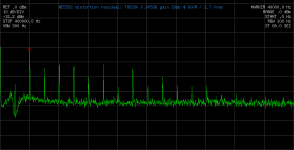 ne5532_dist_residual_gain10.png7 KB · Views: 411
ne5532_dist_residual_gain10.png7 KB · Views: 411 -
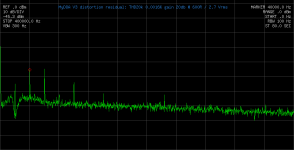 mydoav3_dist_residual_gain10.png6.9 KB · Views: 346
mydoav3_dist_residual_gain10.png6.9 KB · Views: 346 -
 lm4562_dist_residual_gain10.png6.9 KB · Views: 317
lm4562_dist_residual_gain10.png6.9 KB · Views: 317 -
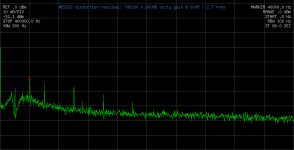 ne5532_dist_residual_gain1.png6.8 KB · Views: 337
ne5532_dist_residual_gain1.png6.8 KB · Views: 337 -
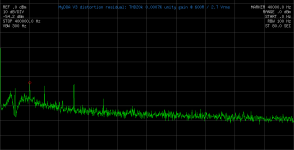 mydoav3_dist_residual_gain1.png6.9 KB · Views: 339
mydoav3_dist_residual_gain1.png6.9 KB · Views: 339 -
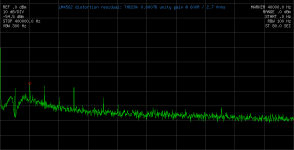 lm4562_dist_residual_gain1.png6.9 KB · Views: 366
lm4562_dist_residual_gain1.png6.9 KB · Views: 366 -
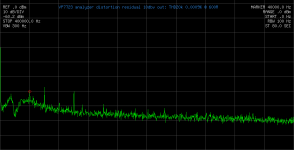 vp7723_dist_residual_10dbv_out.png6.9 KB · Views: 1,203
vp7723_dist_residual_10dbv_out.png6.9 KB · Views: 1,203 -
 vp7723_dist_residual_-10dbv_out.png6.7 KB · Views: 1,223
vp7723_dist_residual_-10dbv_out.png6.7 KB · Views: 1,223 -
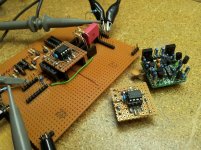 test_setup.jpg952.6 KB · Views: 618
test_setup.jpg952.6 KB · Views: 618
Last edited:
... my_doa_v3 (LTP: BC550C, enhanced VAS)
Dear Toni,
My Congratulations to Yours results achieved 🙂
I feel You nail it closely to Bursons, it is not only measured thd an noise that counts but way much more to the transient-dynamic ability for the DOA v3 to pass much more current in time domain at needed speeds at the transients demanded by a complex music eg. Mahler 8th. symph. with full tutti - choir + orchestra at the loudest passages to easily follow even the single instruments or the individual sections of the whole happening on the stage. Here are under covered the true qualities of Your DOA comparing to the small and polished silicon cross section areas packed in a tinny small dip or sot packages. I think the listening comparation should be the final proof for You and also for the others admiring Yours work You've done so fare. So please follow Yours ears and continue - You'll be surprised . . .
With my best regards
Andreas
Toni, I didn't say NJM4562 is comparable to LM4562.I do not agree that NJM4562 is comparable to LM4562. It is not even as good as NE5532. It was more or less a marketing trick to get more people buying their product. I personally would never use NJM4562 in the audio signal path.
I said "If you need the good ein but not the other supa stuff of LM4562, NJM4562 is a good trouble-free alternative."
I do have some applications where LM4562 will show clear advantage over NJM4562 but they are VERY specialized.
For NwAvGuy's example, (simple amp with a bit of gain) I doubt even you can distinguish them ... and you are one of the small handful of people on this august forum that can sensibly measure down to 1ppzillion.
For most applications, da supa specs of LM4562 are just not achievable for loadsa 'real life' reasons. Kingston's thread on groupDIY shows this very clearly.
On the other hand, the evil latching behaviour of LM4562 IS very evident on many 'real life' applications where it is a VERY poor choice.
__________________
There is more to OPA choice than even what gurus Self, NwWavGuy & Groner measure.
One example is the OPA134 family. It has 2 features that even these gurus don't see but are extremely important for the 'real world' and known only to the better designers of professional stuff.
- much less fussy about poor decoupling/layout/ grounding though you should always be paranoid about such things.
- much better 'real life' EMI/RFI immunity. I know some very serious engineers who favour it just for this though they take all the other paranoid measures against EMI/RFI
____________________
NJM have a favourite topology which they use in practically all their OPAs but customised in various ways.
It goes back to Raytheon 4136 and is also used in LM833 (and other good OPAs which Self & NwWavGuy damn with faint praise). But in fact it IS a good pnp i/p alternative to NE5532 (one of my favourites too.) Its just they lost the marketing war.
IMHO, one big point in its favour is it is a very simple topology which NJM have shown is capable of excellent performance in many directions when customised. Simple topologies don't have evil stuff like latching and are also less fussy.
Of course, the big disadvantage is the 'NJM' label and the fact that much inexpensive stuff use them 😀
___________________
Toni, did you have a bad experience with NJM4562?
No - not directly. If I would need a light sensor controller - maybe I would buy the NJMs. As I have said before "I personally would never use NJM4562 in the audio signal path."....
Toni, did you have a bad experience with NJM4562?
Back to my off topic "MyDOA v3" - is it worth to continue development?
BR, Toni
- Home
- Amplifiers
- Solid State
- 2stageEF high performance class AB power amp / 200W8R / 400W4R
